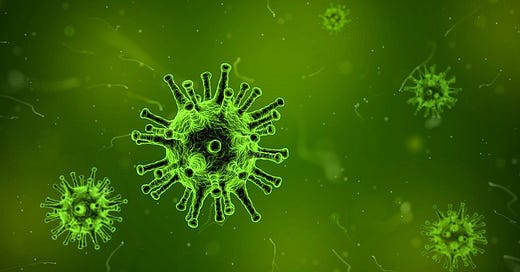India Treats Medical Staff Prophylactically and Early, and It Makes a Difference
The Chloroquine Wars Part XXXI
Throughout the pandemic I have talked to numerous doctors around the world, but more from India than any other nation outside the United States. Today I met Dr. Vipul Shah during a conversation on Clubhouse, and he shared a lot of interesting information. Before I jump into the details, here are a number of facts about the ways in which India handled the pandemic that I already knew:
While hydroxychloroquine (HCQ) is derived from the bark of the Cinchona tree originally from Peru, most HCQ production today takes place in India, which ordinarily exports more than 100 million doses for per month, so the medical community there is highly familiar with it. This includes HCQ's generally mild side effects and also its less standard uses.
India published most of the reports on HCQ prophylaxis early on during the pandemic. This paper (Chatterjee et al) may have been the first aside from media reports. The dose-response curve was enough that the Indian Council of Medical Research (ICMR) encouraged greater prophylaxis usage.
The first RCT on HCQ PrEP was the Battacharya paper on a bit over 100 health care workers (HCWs) showing an 80% effect size. In the meantime, India had ramped up observation of results in HCWs into the thousands, observing convincing clinical benefits.
The Khurana paper (again on HCWs) found that a full course of HCQ prophylaxis was highly preventative of COVID-19, later confirmed in consistency by Goenke et al (87% lower incidence of COVID-19).
In Mumbai, several thousand police officers were put on a similar HCQ prophylaxis protocol, with very few getting sick with mild illness, and none died.
All this data informed prophylaxis and treatment policy in India, which has had a fraction of the COVID-19 deaths (per million population) of almost all Western nations. From this article in The Indian Express from last July (emphasis mine):
Authorities say that the analysis is ongoing as is the drive, in accordance with the ICMR recommendation for prophylactic use of HCQ. VMC Health Officer Dr Devesh Patel says, “The debate around HCQ is founded in the side effects of long term use of the drug for treatment of rheumatoid arthritis and other illnesses… So far, HCQ has not been used as a prophylactic… To us, it has shown positive results. We have the numbers and not one person has complained of complications. The only side effect reported is mild gastritis, which is common with administering heavy medicines and can be effectively handled.”
It seems fair to interpret "not been used as a prophylactic" as "not yet been widely used" given the above observations. But if I understood Dr. Shah correctly, these programs did expand further---particularly among HCWs. Dr. Shah serves on a panel with four other physicians that put together protocols used to treat Indian medical staff during the pandemic. During the first wave, the primary antiviral used was HCQ, and during the second wave (after Facebook censored his account where he was communicating with others in a large nation) they shifted to ivermectin due to HCQ controversies. Similarly to the way Dr. Brian Tyson attacked COVID-19 with an early multi-drug regimen, numerous other medicines, including aspirin, were used. Of Dr. Shah's 8,000 or so patients, only 5 succumbed to COVID-19. This is notably similar to the results of Dr. Didier Raoult.
Dr. Shah mentioned that during the second wave, vaccines may have helped, too. But this means that the HCQ protocol used during the first wave worked excellently on its own. While the overall vaccination rate in India is low, Dr. Shah said that 90% of the HCWs have been vaccinated. To note, India has not used either of the mRNA vaccines. Two adenovirus vaccines and one inactivated-virus vaccine (Covaxin) have been deployed.
Edit: During the second wave, Dr. Shah has already been using fluvoxamine with patients.
Dr. Shah went on to mention that around 1,300 HCWs have died from COVID-19. India has a similarly sized population of HCWs, including physicians, as the U.S., but around three times as many HCWs have died from the disease in the U.S. More importantly, I previously noted that Indian states/territories Maharashtra and Delhi were among those that eschewed the early treatment antivirals. At around the end of the first COVID-19 wave in India, those same two states comprised a full 60% of the deaths to HCWs despite housing 10% of India's overall population, which is to say that HCWs in Maharashtra and Delhi had 15 times the COVID-19 mortality rate as in the rest of India. The naysayers can try to claim that among the slums there is undercounting of deaths. But that's harder to claim among a community of physicians that are tracked well enough that we know how many of them are vaccinated.
In other news, I received a small batch of early treatment data from Dr. Lionel Lee. His early treatment protocol included HCQ, azithromycin, zinc, vitamin C, aspirin, and steroids where needed. The only patient in the data pool who died refused treatment. I have not yet performed the data check with the county epidemiologist.
As I continue to gather such data, as I confirm it in whatever ways are available (if it is already published, I will assume confirmation), I will be releasing preliminary and aggregate data results at www.earlyc19treatmentdata.com. The domain is still migrating, so I haven't yet built the basic site, but you can bookmark it if you want to follow the project.





Mathew, thanks for all of your hard work. Thanks for sharing DarkHorse Podcast on Ivermectin. Best rabbit hole ever!
Share, share, share❤️